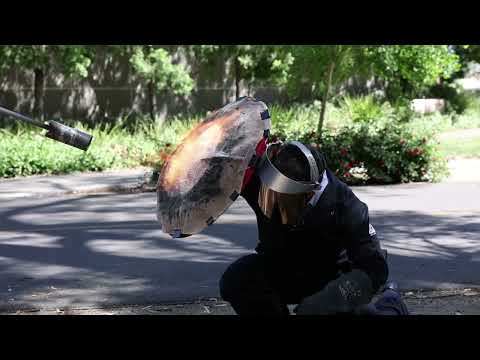
What’s the weirdest thing you learned this week? Well, whatever it is, we promise you’ll have an even weirder answer if you listen to Popular Science’s hit podcast.
The Weirdest Thing I Learned This Week hits Apple, Spotify, YouTube, and everywhere else you listen to podcasts every-other Wednesday morning. It’s your new favorite source for the strangest science-adjacent facts, figures, and Wikipedia spirals the editors of Popular Science can muster. If you like the stories in this post, we guarantee you’ll love the show.
Check out Weirdest Thing’s new page on Reddit to meet fellow Weirdos!
FACT: Orangutans can self-medicate—and even rub themselves down with soothing balms
Back in 2022, researchers were observing primates in Indonesia. One of the 150 orangutans they were watching that day had a nasty looking open wound on his flange, which is the proper term for those big, plate-like cheeks orangutans are packing. There’s a picture, and honestly I did not enjoy looking at it, because this poor guy had a sizable chunk of his face missing.
Unfortunately, a wound like that isn’t particularly noteworthy for researchers in the field—males inflict injuries like this on each other when they fight. But the behavior of the wounded orangutan, an adult in his mid-30s called Rakus, absolutely got their attention. They saw him putting crushed leaves and sap into the wound.
Rakus was providing a particularly exciting example of zoopharmacognosy, which is when non-human animals self-medicate. While there are a lot of unique things about his routine—you can listen to this week’s episode of The Weirdest Thing I Learned This Week to find out more about all that—he’s far from the first animal to use medicinal herbs.
One of my favorite examples of self-medication is also in orangutans. In the Sabangau peat swamp forest in Central Kalimantan, Bornean orangutans—mostly females, but some males—have been observed using leaves of the anti-inflammatory Dracaena cantleyi plant for something of a skincare routine. They chew the leaves for several minutes, then rub the resulting juice all over their arms and legs. They can engage in this lathering for more than half an hour. Because humans are known to use this plant as a topical treatment for joint and muscle pain (for which it’s quite effective), the researchers think orangutans are doing the same. That could even explain why females are more likely to indulge: they carry their babies around in their arms all day, which probably leaves them pretty sore.
For more on self-medicating apes (and a few cheeky monkeys), check out this week’s episode of The Weirdest Thing I Learned This Week.
FACT: Our future robot overlords might move like roller derby players
My latest book (it just came out yesterday, in fact) is about how disinformation, propaganda, and violent threats—the essential tool kit for psychological warfare—have evolved from military weapons deployed against foreign adversaries into tools in domestic culture wars. But I also write sci-fi, and one project I’m currently working on involves a robot with wheels for legs. In searching for real-world robots I might use to flesh out her character, I came across one so adorable I knew I had to share it with the Weirdest Thing crew: a sweet little delivery guy on wheels.
What’s fun about this robot design is that it doesn’t try to replicate anything that exists in nature. Its engineers worked problem-first, aiming to figure out ways that wheels could maneuver up stairs and other obstacles. Rachel pointed out that the use of the edge of the wheel for stability and agility is pretty similar to how roller derby players use their skates!
You can hear more about the evolution of this little bot in this week’s episode. Or you can just head over to YouTube to see it in (adorable) action.
FACT: Huffing your cat is a lot like smelling your loved one’s armpit
By Amanda Reed
Have you all seen the tweets that are like, “I love smelling my boyfriend’s armpits?” I am like that with my cat, JunkJunk, minus the armpit part. I love putting my face in his fur and taking a big whiff. I can only categorize his scent as “smelling your bed after coming home from a trip.” It’s not clean laundry, but it smells like home. Turns out, I’m not alone in this. There are reasons why a cat smells a certain way—and the same chemical reactions that make us like our loved one’s armpit smell come into play when you sniff your pet cat.
A cat’s smell is greatly influenced by several factors, such as what they eat, what breed they are, and how much they clean themselves. Cats also have nine scent glands, located all over their body, including their paws, chin, nose, and the base of their tail.
Cats who give off a nutty scent are secreting pheromones from their Pinna glands, which are just behind their ears. It’s also often described as earthy and similar to Jasmine rice. Humans technically can’t detect anything from these scent glands, but it’s worth noting the coincidence.
Cats also secrete compounds that contribute to smell. They secrete a ketone called 4-thio-4-methylpentan-2-1, which is light, fruity, and powdery. It’s most strong in female cats or neutered males. If you’ve ever smelled a black currant bush and been like “it smells like cat pee”—congrats! Both cat urine and black currant bushes contain varying concentrations of this ketone.
Sometimes, a cat might smell sugary, like maple syrup or cotton candy, but this could mean they are suffering from diabetes mellitus. This condition can trigger a sweet or fruity smell to come from a cat’s mouth. Meanwhile, big cats, like leopards, tigers, and lions, have a compound in their urine called 2-AP, which smells like buttered popcorn.
Our brain associates scents with emotion and memory. When we recognize our loved one’s scent, our brain releases oxytocin, which is often called the “love hormone” or the “cuddle hormone.” Recognizing your cat’s smell has the same effect. So sniff and cuddle to your heart’s content—who could blame you?





